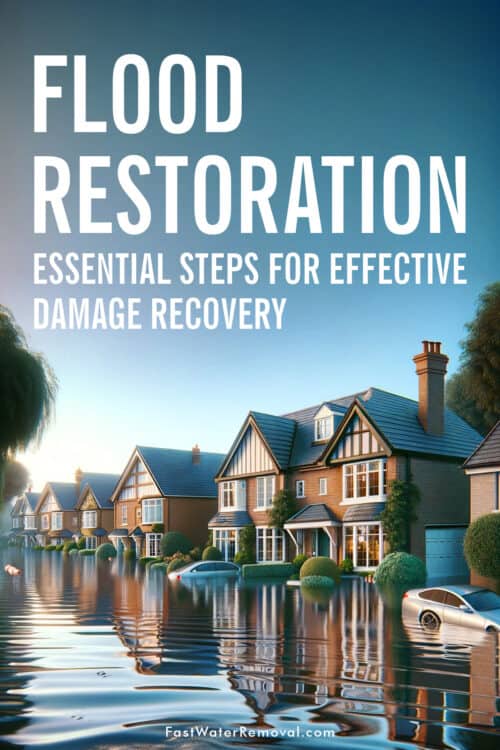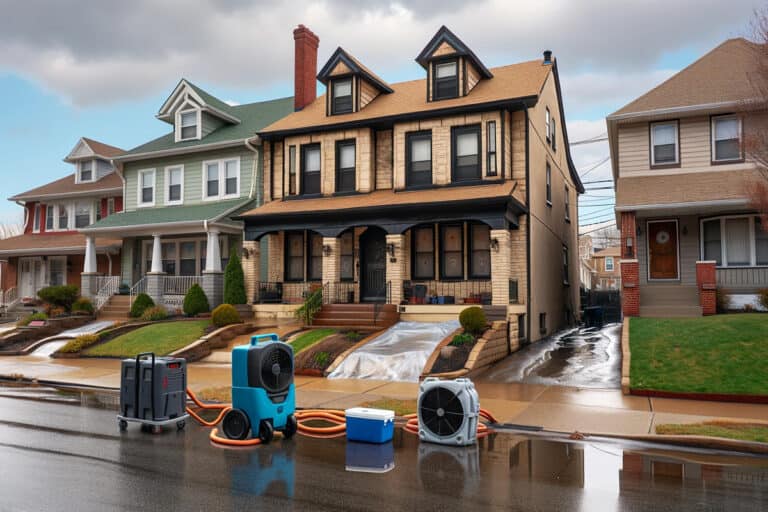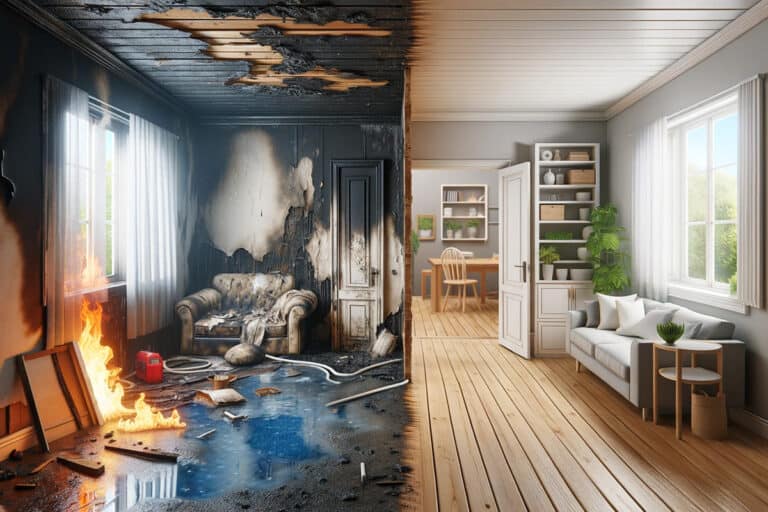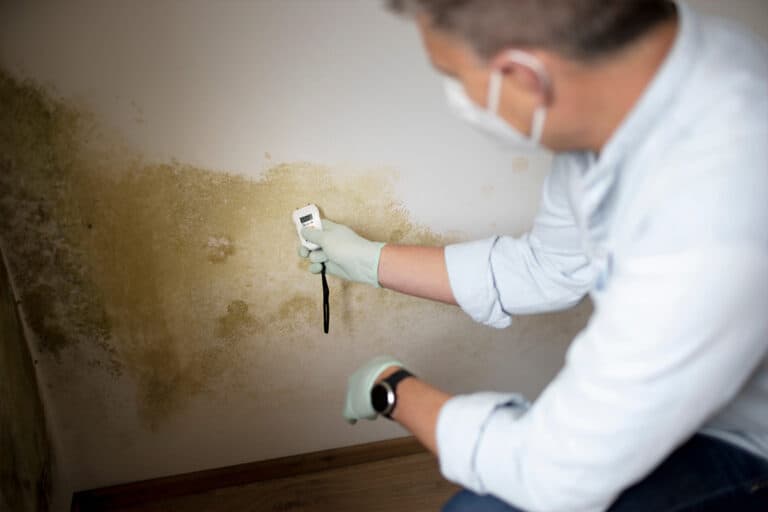Disclosure: I am compensated for purchases made through some links on this site. Click for details.
Flood restoration is a comprehensive process undertaken to reclaim homes and properties that have been devastated by floodwaters. Water damage can lead to a compounding series of events, often starting with the destruction of property and evolving into long-term issues such as mold, structural damage, and even health hazards if not promptly and properly addressed. Homeowners must understand the extent of damage and engage with professional restoration services to ensure their property is safely and effectively restored to its pre-flood condition.
Navigating the aftermath of a flood involves immediate attention to safety measures, assessing the damage, and initiating the cleanup process. A swift response can considerably mitigate the impact of flooding. Homeowners with flood insurance should document the damage meticulously and work closely with their insurance providers to cover the restoration costs, including the initial cleanup and subsequent repairs.
Among the top priorities in flood restoration are removing the floodwaters, dehumidifying the affected areas, salvaging any recoverable items, and thoroughly disinfecting to eliminate health risks from contaminants. The goal is to ensure the structure is dry, safe, and habitable once again. Preventative measures are also recommended post-restoration to help safeguard against potential future flood events, sustaining the longevity of the property.
Key Takeaways
- Flood restoration involves extensive cleanup and repair to address immediate and long-term water damage.
- The insurance process is critical for funding the restoration and should be initiated quickly after the damage assessment.
- Effective restoration also includes implementing preventative strategies to minimize future flood risks.
Understanding Flood Damage
When floodwaters recede, the impact on a property is categorized into varying degrees of water damage, making prompt and appropriate actions crucial. Recognizing the type of water damage and understanding the associated health risks, such as mold and mildew, are the first steps to effective restoration.
Types of Water Damage
Water damage can be identified as one of three categories based on contamination level. Category 1 involves clean water, stemming from sources like water lines or rainwater. Category 2 is ‘gray water’, which contains significant chemical or biological contamination, originating from sources such as dishwasher leaks or sump pump failures. Category 3 is ‘black water’, highly contaminated, often due to sewage or flooding from rivers and streams. Restoration efforts vary greatly between the categories, with Category 3 requiring strict safety protocols.
Health Risks of Mold and Mildew
Mold and mildew pose significant health risks in the aftermath of flood damage. They thrive in damp environments, quickly taking hold within 24-48 hours of water exposure. Mold can cause a range of health issues, particularly respiratory problems, allergic reactions, and immune system suppression. It is essential to address mold damage immediately, ensuring removal is thorough to safeguard occupants’ health and the structural integrity of the property.
Initial Response and Safety Measures
In the wake of a flood, the initial response is critical for the safety of occupants and the integrity of the structure. Key focuses are on assessing the extent of water damage, adhering to strict safety precautions, and promptly contacting appropriate authorities.
Assessing the Damage
One must inspect the area for visible structural damage, such as warping, loosened or cracked foundation elements, cracks, and holes before entering the building. If the residence appears stable, they should carefully document the extent of water damage. Photography, when possible, provides a record for insurance claims and flood restoration efforts.
Safety Precautions
Safety measures prioritize turning off electrical power to mitigate risk of electrocution. Individuals should avoid contact with floodwater as it may contain hazardous contaminants. They should wear personal protective equipment (PPE), including gloves, boots, and masks, while maneuvering through affected areas, as recommended by OSHA.
Contacting Authorities
Contacting local authorities can provide information on the safety of the water supply and any public health advisories. It is imperative to report electrical damage to the utility company and to engage professional services for emergency response and water damage assessment and restoration. Authorities can also direct individuals to aid resources and recovery assistance.
Insurance Process Overview
The insurance claim process is a crucial step for homeowners recovering from flood damage. Initiating a claim promptly and accurately ensures sufficient compensation and restoration of the property. Understanding the roles and responsibilities of both the policyholder and the insurance company can expedite the process.
Filing a Claim
A policyholder should file their claim as soon as possible after experiencing flood damage. The insurance company typically requires notification within a specific timeframe to consider a claim valid. Policyholders need to provide their policy number and a brief description of the damage.
The Role of the Adjuster
An adjuster, assigned by the insurance company, plays a key role in evaluating the extent of flood damage. They inspect the property, ascertain the damage severity, and determine the claim’s validity. Their assessment is critical in how much the insurance company will compensate the policyholder.
Documenting Damages for Claims
It is essential for policyholders to meticulously document all flood damage for the claim. This includes taking photographs or videos, listing damaged items, and noting the date of the flood. Accurate records support the adjuster’s evaluation and help facilitate a fair insurance settlement.
Cleaning Up After a Flood
Cleaning up after a flood involves a series of critical steps to restore your property to a safe and livable condition. Immediate attention to water removal, drying, disinfecting, and sanitizing is essential to prevent further damage such as mold growth and water damage to structures and belongings.
Water Removal
The first step in the cleanup process is to remove standing water as quickly as possible. Industrial-grade pumps and vacuums are typically employed for this task to efficiently handle large volumes of water. It’s crucial that this step is started promptly to minimize structural damages and reduce the risk of mold formation.
Drying and Dehumidification
Once water is removed, the affected areas need thorough drying and dehumidification. Using air movers and dehumidifiers helps in drawing out the remaining moisture from walls, floors, and furnishings. It’s important that they ensure the space is completely dry, as residual moisture can lead to mold and mildew.
Disinfecting and Sanitizing
After the property is dry, all areas that were in contact with floodwater must be properly disinfected and sanitized. This includes applying antimicrobial treatments to eliminate bacteria and viruses that could pose health risks. Additionally, they must address mold by cleaning and sanitizing any surfaces where mold has started to grow to prevent its spread.
Remember, a professional flood restoration service can provide thorough and efficient cleanup to ensure your property is safe following a flood. They offer 24-hour emergency service minimizing the risk of secondary damages.
Restoration Process
The flood restoration process encompasses a series of steps crucial to returning a property to its original state. These steps include making structural repairs, restoring power and utilities, and carrying out thorough reconstruction and finishing.
Structural Repairs
Firstly, assessing and repairing structural damage is paramount. Flood damage can compromise the integrity of a building, so professionals often utilize permanent repair solutions that are designed to protect the home from future harm. Engineers and contractors work to ensure that the property’s foundations and main structures are safe and sound.
Restoring Power and Utilities
After addressing the structural concerns, electricians are engaged to inspect and repair the electrical systems. Water damage can lead to significant electrical hazards, therefore the utmost care is taken to restore power safely. This task involves careful examination of wiring, fixtures, and devices, and it’s crucial to adhere to regulatory standards for the safety of the occupants.
Reconstruction and Finishing
Once the structure is stabilized and utilities restored, the focus shifts to reconstruction and finishing, which entails drywall replacement, painting, and flooring. Teams follow a specific sequence to optimize the restoration process, with a comprehensive approach to flood restoration guiding the refurbishment of each room affected by the flood. The goal is to not only repair but also to improve the property to its pre-flood condition or better.
Preventing Future Flood Damage
Effective protection against future flood damage hinges on proactive measures in water management, structural reinforcement, and diligent upkeep of property. Homeowners should focus on improving drainage, proofing their homes against floods, and performing regular maintenance checks.
Improving Drainage
Drainage systems play a crucial role in preventing water accumulation that can lead to flood damage. Homeowners should ensure that their property is graded in a way that channels water away from the foundation. The installation of French drains or sump pumps might be necessary to enhance their property’s ability to manage excess water effectively.
Flood Proofing Your Home
When flood proofing, consider applying coatings and sealants to the foundation, walls, windows, and doorways that can resist water penetration. Installing check valves in the sewage lines can prevent backed up water from entering the home. Raising electrical outlets, switches, and other service components to at least one foot above the projected flood elevation can safeguard electrical systems from water damage.
Regular Maintenance Checks
Regularly inspecting and cleaning gutters, downspouts, and drains is essential to maintain an optimal drainage system. It is important to check for and repair any cracks or gaps in the foundation or sealants, as even small breaches can allow floodwaters to enter. They should arrange for a professional inspection of their property’s structural integrity to ensure resilience against future floods, focusing especially on areas that have previously sustained flood damage.
Conclusion
Flood restoration is a challenging and intricate process, but with the right approach, it can effectively bring a property back to its former glory. The journey from the immediate aftermath of a flood to full restoration is marked by diligence, safety, and attention to detail. Homeowners must prioritize immediate response measures to mitigate damage, work closely with insurance companies to cover the costs of restoration and engage professional services for thorough cleanup and repair. The process of water removal, drying, dehumidification, and disinfection is crucial to preventing long-term issues like mold and structural weakness.
Moreover, the restoration phase goes beyond mere repairs, encompassing thoughtful reconstruction and consideration for future flood prevention. Implementing strategies like improving drainage, flood-proofing homes, and regular maintenance checks are key to reducing the likelihood and impact of future flooding.
In summary, flood restoration is more than just a response to an immediate crisis; it’s a step towards resilience and sustainability. By understanding the complexities of flood damage and adopting a proactive, comprehensive approach to restoration, homeowners can not only recover from the immediate effects of a flood but also fortify their properties against future challenges. Remember, the safety and well-being of the occupants is paramount, and every step taken towards restoration plays a vital role in securing a safe, healthy, and sustainable living environment.






